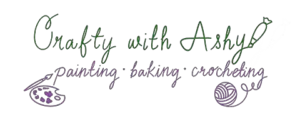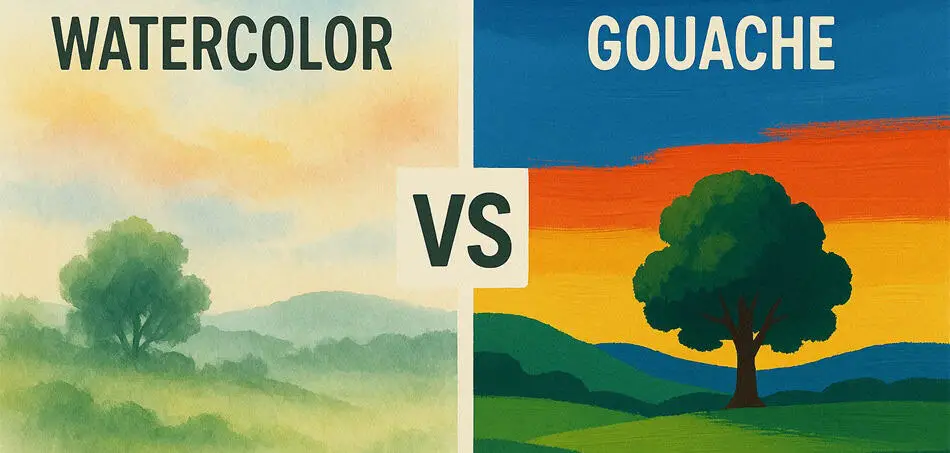When it comes to painting, artists have a variety of mediums to choose from, each offering unique characteristics and effects. Watercolor and gouache are popular and convenient options; both have distinct advantages.
In this post, we’ll explore the differences between watercolor and gouache, examining their properties, techniques, applications, and what makes each medium special.
What is Watercolor?
Watercolor is a painting medium made of pigments suspended in a water-soluble binder. The primary characteristics of watercolor paint are its transparency and fluidity. When applied to paper, the colors can create soft, translucent layers that allow light to penetrate and reflect off the white surface beneath, giving watercolor paintings a luminous quality.
What is Gouache?
Gouache is an opaque watercolor medium that also uses water as a solvent. It combines the characteristics of traditional watercolor with the added element of opacity, making it versatile for various applications.
**A variation of gouache, called acrylic gouache, is NOT water soluble. This post is not about acrylic gouache.
Properties of Watercolor
Transparency: Watercolors are known for their transparency. Layers of paint can be built up, allowing underlying colors to show through, adding depth and complexity to the artwork. This transparency also allows for glazing and optical mixing. When you layer two different colors, the transparency results in optical mixing, which creates new colors (for example, layering a transparent blue over dried yellow will create a green).
Fluidity: Watercolor paint is activated by water, making it easy to dilute and spread. This fluidity allows for unique blending techniques and washes, creating soft gradients and washes of color.
Quick Drying: Watercolor dries relatively quickly, allowing artists to work in layers. Because watercolor is a water-activated medium, it can be reactivated after drying to manipulate or blend further. Some pigments are more staining and permanent than others, though, so mistakes can sometimes be challenging to rectify.
Surfaces: Paper is typically the support used for watercolor painting. Watercolor paper is designed to handle water without disintegrating, warping, or buckling. It often has a textured surface that influences the final appearance of the painting.
Properties of Gouache
Opacity: Unlike watercolor, gouache is opaque. This means it can completely cover underlying colors, allowing for bold, vibrant applications and adding highlights (lighter) over darker colors.
Body: Gauche is often used straight from the tube, and its thick consistency creates full coverage.
Matte Finish: Gouache dries to a matte finish, providing a unique aesthetic versus acrylic and oil paints.
Surfaces: Gouache can be applied to various surfaces beyond paper, including canvas, wood, and illustration boards, making it a flexible choice for different projects.
Comparing Properties of Watercolor and Gouache
| Feature | Watercolor | Gouache |
|---|---|---|
| Transparency | Transparent | Opaque |
| Body | Thinner and fluid | Thick and creamy |
| Drying Time | Very fast (seconds to minutes) | Watercolor paper or a surface primed with watercolor ground |
| Re-wetting | Reactivated with water | Reactivated with water |
| Surfaces | Stays where placed and does not bleed as much | Watercolor paper, mixed media paper, wood, illustration board |
| Finish | Matte, light, luminous, | Matte, velvety |
| Layering | Builds up in transparent glazes | Can layer opaquely, allowing for corrections |
| Drying | Dries lighter | Dries darker |
| Flow | Flows and blends easily when water is added | Also reworkable, but generally not as much; it can cover areas by layering |
| Opacity Control | Controlled by amount of water used | Controlled by amount of water used |
| Portability | Extremely portable (especially in pan sets) | Still portable, but tubes can be bulkier |
| Common Uses | Landscapes, botanicals, atmospheric work | Illustration, posters, flat-style painting, mixed media |
| Reworkability | Easy to lift or rework (but may stain paper) | Also reworkable, but generally not as much; can cover areas by layering |
| Lightfastness | Depends on the pigment, but some colors fade faster | Depends on the pigment, but some colors fade faster |
Watercolor Techniques
There are a ton of different techniques used in watercolor, and I have a whole post dedicated to terminology, including techniques, in watercolor HERE (ADD LINK). But below are a few that are pretty unique to watercolor.
Wet-on-Wet: This technique involves applying wet paint onto wet paper, resulting in soft, diffused edges and beautiful blends. This technique is a main draw of watercolor painting and is very therapeutic. Watching those colors explode and dance on the page is always an exciting experience.
Dry Brush: Artists can create textured effects with white space and fine details using a dry brush with minimal water.
Glazing: Layering transparent washes over dried layers to build depth and luminosity.
Salt Technique: Sprinkling salt on wet watercolor creates interesting textures as the salt absorbs the pigment and leaves behind a unique pattern.
Gouache Techniques
Flat Wash: Applying a uniform layer of gouache can create a smooth, solid color application.
Layering: Since gouache is opaque, artists can layer colors on top of one another without losing vibrancy, allowing for corrections and adjustments.
Scratching: Using a tool to scratch into dried gouache can create textures and patterns, adding dimension to the work.
Mixing with Other Mediums: Gouache can be combined with other mediums, such as acrylic, for unique effects and finishes.
Comparing Watercolor and Gouache Techniques
| Technique | Watercolor | Gouache |
|---|---|---|
| Wet-on-Wet | Applied to wet paper for soft blends and diffused edges | Less common: gouache tends to sit on the surface and doesn’t flow as freely |
| Wet-on-Dry | Used to create crisp edges and defined shapes | Used to create crisp edges and defined shapes |
| Dry Brush | Common technique for creating texture | Effective, but not as commonly uses |
| Glazing | Transparent layers build depth and luminosity | Possible, but must be thinned significantly and applied carefully after under layers are fully dry |
| Lifting | Easy to lift while wet or damp (some pigments may stain) | Liftable, though it may disturb underlying layers |
| Salt Texture | Salt on wet paint draws pigment to create starburst patterns | Rarely used; less dramatic due to thicker consistency |
| Backruns/Blooms | Occur when wet paint spreads into damp areas — can be intentional or accidental | Minimal in gouache due to its thicker consistency |
| Flat Wash | Often used but can be tricky to achieve without streaks due to transparency | Easily achieved and Ideal for smooth, solid areas of color |
| Layering | Worked from light to dark and uses transparent glazes to build gradually | Opaque layers allow bold corrections and layering light over dark |
| Scumbling | Light, semi-dry brushing to soften or add texture | Works similarly, with more opacity and a chalk-like finish |
| Scratching/Sgraffito | Scratching into semi-dry paint reveals paper or underlayers | Effective and dramatic when scratched into thick gouache, creates more 3D texture |
| Splattering | Used for organic effects like stars, foliage, or texture | Works in gouache too, but must be thinned |
| Masking | Masking fluid is used to block off white areas | Gouache can be painted directly over dried areas instead of requiring masking |
| Mixing with Other Mediums | Fun! Do it! | Fun! Do it! |
| Blending | Very natural and seamless when done wet-on-wet or with damp edges (Water does the work) | Possible, but thicker applications have to be physically worked with the brush to blend |
Applications
Watercolor Applications
Landscape Painting: Watercolor’s fluid nature makes it an excellent choice for capturing the essence of landscapes, skies, and natural elements.
Illustration: Many illustrators favor watercolor for its delicate and whimsical appearance, often seen in children’s books and fashion illustrations.
Botanical Art: Watercolor’s ability to layer colors softly is perfect for rendering flowers and plants with a sense of realism.
Portraits: Watercolor portraits offer a light, luminous quality to the skin and can be built up in layers to create depth and detail.
Gouache Applications
Graphic Design: Gouache’s opacity and bold colors are well-suited to graphic design work, including posters and advertising.
Vibrant Art: Gouache lends itself nicely to painting styles that go beyond the realistic. Using non-native colors in a bright, bold fashion is an excellent application for gouache.
Concept Art: Many concept artists use gouache because it is versatile, allowing for quick adjustments and rich color applications.
Children’s Art: Gouache’s vibrant and forgiving nature makes it an excellent medium for children, allowing them to explore and create without fear of making mistakes. It is also generally washable since it is activated with water. There are exceptions for staining colors.
Choosing Between Watercolor and Gouache
Deciding whether to use watercolor or gouache depends on your artistic goals, style, and preferences. Here are some factors to consider:
Desired Aesthetic: Watercolor is the way to go if you want a soft, transparent look. If you prefer bold colors and a matte finish, gouache may be your medium of choice.
Working Style: Due to its fluid nature, watercolor requires a more controlled approach, while gouache allows for more flexibility in layering and corrections.
Project Requirements: Consider your project’s requirements. If you’re working on a detailed illustration that demands opaque colors, gouache may be more suitable. If you’re capturing the ethereal quality of a landscape, watercolor might be the better fit.
Experience Level: Beginners may find gouache easier to manage because of its opacity and forgiving nature. Watercolor, while rewarding, can be more challenging due to its unpredictable behavior.
Conclusion
Watercolor and gouache are beautiful and versatile mediums that produce stunning artwork. Each has its strengths and ideal applications, and the choice between them often comes down to personal preference. Many artists work with both mediums, as there are many similarities, and choose the medium based on the project they are creating that day. By experimenting with both mediums, artists can discover their unique styles and expand their creative repertoire.
Whether you’re drawn to the delicate washes of watercolor or the bold vibrancy of gouache, both mediums offer endless possibilities for expression and creativity. So grab your brushes, explore the unique characteristics of each, and enjoy the journey of painting!
Now it is time for YOU to get Crafty with Ashy!
Be sure to subscribe and follow me so you don’t miss any inspiration!

